
![]() Educational activities carried out in the museum with specialised museum educators, enriched also with specific kits to continue the experience in the classroom or with proposals to learn/improve a foreign language (LS) through integrated learning of content and language, with the CLIL (Content and Language Integrated Learning) methodology.
Educational activities carried out in the museum with specialised museum educators, enriched also with specific kits to continue the experience in the classroom or with proposals to learn/improve a foreign language (LS) through integrated learning of content and language, with the CLIL (Content and Language Integrated Learning) methodology.
The activities range from infant school to the Higher Education System (Universities etc.)
Here a full listing of activities. Visit our reservation website for bookings >
![]() Painted Gold. El Greco and Art between Crete and Venice
Painted Gold. El Greco and Art between Crete and Venice
Venice, Doge’s Palace
From 30 April to 29 September, 2025
Guided itinerary
A golden thread links the historical and artistic events, the diplomatic balances and the devotion in the Mediterranean area along the route between Venice and Crete, or Candia as it was known from the thirteenth century, when it became the pearl of the Serenissima’s Stato da Mar. Painted gold, which makes icons shine with spiritual light, is the protagonist of the exhibition at the Doge’s Palace, and provides the backdrop to a long history of intense pictorial relations between the two islands. After the fall of Constantinople in 1453, Candia became the most important artistic centre for the ancient Byzantine tradition, which saw the involvement of over a hundred workshops of ‘madoneri’, especially iconographers producing popular devotional images. At the same time, Venice – like a new Byzantium – welcomed a growing influx of artworks and artists from the Aegean islands. Iconographers, or painters of icons, travelled or immigrated between Crete, the Ionian Islands, and the Venetian capital. This led to a unique synthesis between the native Byzantine courtly tradition – already an essential element of Venetian artistic heritage – and the Western figurative language, which evolved from late Gothic to the Renaissance, becoming more human-centred, naturalistic, and dynamic. A fortunate relationship developed and remained unbroken between the golden age of the Venetian Renaissance in the fifteenth and sixteenth centuries and the early nineteenth century, marked by moments of always original symbiosis. The guided tour illustrates this unique pictorial journey through seven sections of the exhibition; at the heart of this fascinating narrative of history and painting stands the most famous and extraordinary figure of the ‘school’: Dominikos Theotokopoulos, or El Greco (1541–1614). Born in Crete, he began his training within the post-Byzantine tradition before making his way to Venice around 1567 – an essential step for artists of the time.
Target: Lower (last year) and upper secondary school and higher education system (Universities etc.)
Duration: 1h 30min
Languages: Italian, English
![]()
Giulio Aristide Sartorio. Il Poema della vita umana
Venice, Ca’ Pesaro – International Gallery of Modern Art
From 16 May to 28 September, 2025
Guided tour
In the spring of 1906, at the invitation of the secretary general of the Biennale, Antonio Fradeletto, Giulio Aristide Sartorio agreed to realise the pictorial cycle called Il Poema della vita umana – ‘The Poem of Human Life’ – to be placed in the Central Hall of the 1907 International Exhibition.
In the four main scenes – Light, Darkness, Love and Death – which alternate with ten vertical canvases (depicting Grace and Art), the artist offers a dramatic vision of existence, from birth to death. Between the two extremes are the allegories of Darkness and the divergence between the figures of Eros and Himeros, good and evil love.
Installed for the inauguration of the 1907 exhibition, the fourteen scenes remained in situ for the following edition of the Biennale and then made their way to Ca’ Pesaro as a gift from King Victor Emmanuel III to the Galleria Internazionale d’Arte Moderna di Venezia in 1909.
Thanks to the Italian and foreign works present at the Biennales in the same years, which later became part of the Ca’ Pesaro collections, and to the extensive documentation from various archives, the guided tour of the exhibition allows visitors to understand fully the meaning of Sartorio’s great cycle and the significance of this splendid page in twentieth-century Italian painting.
Target: Lower secondary schools (last year), upper secondary schools, universities
Duration: 1h 30min
Languages: Italian, English, French and Spanish
![]()
GUIDED TOURS
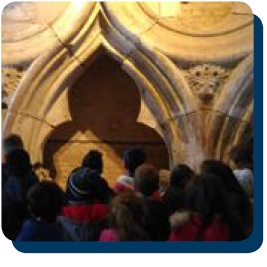 The Lion Hunt
The Lion Hunt
What better than a lion, the very symbol of Venice, to lead children on a more unusual trip around the Doge’s Palace. In this ‘lion hunt’ they must find various painted and sculpted depictions of the animal throughout the Palace, and ‘win’ some items that, put together, will result in a surprise to take home. The tour starts from the courtyard and includes a visit to the most important rooms of the palace, including the Institutional Chambers and the Armoury, excluding the Prisons.
Target: Nursery and primary school
Duration: 2h
Language: Italian, English, French, Spanish, Russian, German
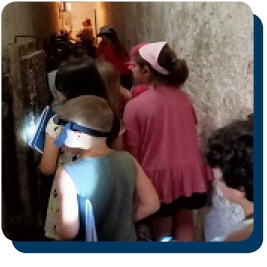 A perfect Venetian crime. Find the culprit in the Doge’s Palace
A perfect Venetian crime. Find the culprit in the Doge’s Palace
A crime that really happened in the Doge’s Palace in the mid-fifteenth century acts as the leitmotif for a guided tour that winds its way through the most significant places in the Palace: from the courtyard to the Institutional Chambers – including those of the Senate, of the Maggior Consiglio – and on to the Bridge of Sighs and the New Prisons.
The aim is to discover the numerous clues that bring to light an intricate affair that took place at the time of rule of Doge Francesco Foscari.
Target: 2nd cycle primary school and lower secondary school (only class I and II)
Duration: 2h
Language: Italian, English, French, Spanish
 The Doge’s Palace: The Symbol of the City
The Doge’s Palace: The Symbol of the City
A dynamic and fascinating guided tour that enables visitors to grasp the extraordinary beauty and complexity of a structure that is the symbol of the city, a building that embodies the highest aspects of Venetian civilisation and was formerly home not only to the Doge but also to the entire state administration. A masterpiece of Gothic art whose interiors also contain marvels of Renaissance and Mannerist architecture, the building is superbly decorated with works by artists such as Titian, Veronese and Tintoretto; in effect, a visit to the palace is one massive story told in pictures. The paintings and sculpture adorning the place, together with the architecture and the layout of its interiors, all reflect – in both symbolic and practical form – the workings of the Venetian Republic, the fundamental importance attributed to the various branches of the judicial system and to the visual manifestation of power. This visit through the heart of the city and its history is essential if one is to fully understand them.
The activity also includes a short visit to the Bridge of Sighs and the New Prisons.
Target: Lower and upper secondary school and higher education system (Universities etc.)
Duration: 2h
Language: Italian, English, French, Spanish, Russian, German
WORKSHOPS
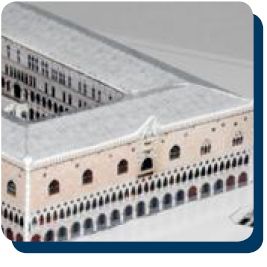 A 3D Palace
A 3D Palace
With degrees of complexity suited to different levels of schoolchildren, this workshop is preceded by a visit to the Doge’s Palace that focuses in particular upon the fabric of the building and its history, upon the construction of an extraordinary architectural “appartus” which was not only the seat of government but also a “conveyor of messages” expressed in works of painting and sculpture. In the workshop, the students will, starting from an exploded-view diagram, create a real 3D model of the Palace which they can then take home with them.
In collaboration with Formacultura
Target: 2nd cycle primary school, lower and upper secondary school and higher education system (Universities etc.)
Duration: 2h 30 min
Language: Italian, English, French, Spanish
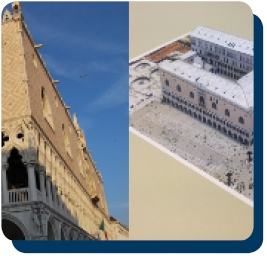 A 3D Palace with Muve toolkit
A 3D Palace with Muve toolkit
With degrees of complexity suited to different school year groups, this interactive visit to the Doge’s Palace focuses in particular on the fabric of the building and its history. It looks at the construction of an extraordinary architectural “apparatus”, which was not only the seat of government but also a “conveyor of messages” expressed through paintings and sculptures. At the end of the visit, a toolkit containing a 3-D cardboard model of the Palace will be provided to all participants with instructions, a short guide to the museum and other materials. The aim is support the school children in the continuation of their experience at home or at school.
In collaboration with Formacultura
Target: 2nd cycle primary school, lower and upper secondary school and higher education system (Universities etc.)
Duration: 2h
Language: Italian, English, French, Spanish
![]()
COMBINED TOURS
COMBINED TOUR IN ST. MARK’S SQUARE MUSEUMS WITH A SINGLE TICKET
(DOGE’S PALACE & MUSEO CORRER)
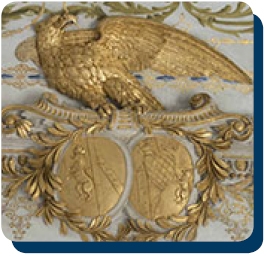 Guided tour: From Doges to Emperors
Guided tour: From Doges to Emperors
A single itinerary leads to the discovery of some of the most important buildings of
St Mark’s Square and Venice: the Doge’s Palace, heart of the Serenissima, and
the nineteenth-century Royal Palace, home to the Museo Correr, located between the Napoleonic Wing and the Procurator Nuove. The visit enables an observation of the splendours of the past and also the visible traces left by the complex and often dramatic historical development which occurred as the Venetian Republic ended and came under the dominion of Napoleonic France and then Habsburg Austria.* At the same time, however, they see how Venice maintained its identity and the fundamentally Italian nature of its art.
*The visit includes a walk through the royal rooms of Empress Elisabeth (‘Sissi’) and the Canovian rooms of the Museo Correr
Target: Lower (only class III) and upper secondary school and higher education system (Universities etc.)
Duration: 2h 30 min
Language: Italian, English, French
![]()
GUIDED TOURS
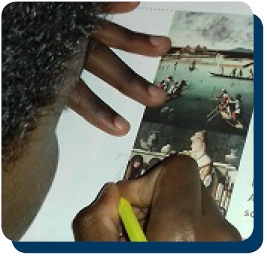 The Art detective
The Art detective
The Museo Correr’s picture gallery – one of the richest and most important collections of Venetian painting from its origins to the early sixteenth century, which includes works by Lorenzo Veneziano, Bellini, Carpaccio, Cosmè Tura, Antonello da Messina and Lorenzo Lotto, presented in an evocati-ve setting by Carlo Scarpa – becomes a ‘playground’.
With the aid of an activity book, story-telling opens the way to the discovery of clues and the resol-ving of puzzles, all of which teach the children how to look at pictures and understand them.
Target: Primary school
Duration: 1h 30 min
Language: Italian, English, French
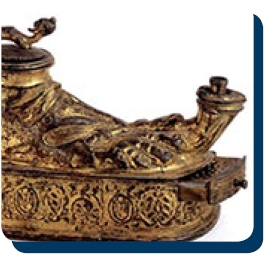 Museo Correr: a museum with a thousand faces
Museo Correr: a museum with a thousand faces
A special tour allows visitors to discover treasures and curiosities constituting the origins of the Venetian Civic Museums. Starting from the Neoclassical rooms, with the important works of Antonio Canova, the tour leads to the precious historical collections illustrating the institutions, urban planning, naval, economic and military power and daily life of the city during its greatest period and political independence, before arriving at the Picture Gallery, where a rich and evocative review of Venetian painting up to the early sixteenth century comes to life.
Target: Lower and upper secondary school and higher education system (Universities etc.)
Duration: 1h 30 min
Language: Italian, English
![]()
GUIDED TOURS
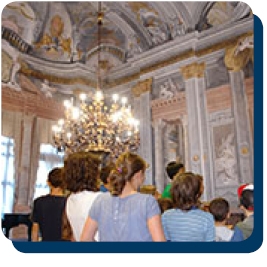 Venice in the eighteenth century
Venice in the eighteenth century
At Ca’ Rezzonico, in the richest of mansions, eighteenth-century Venice and its aristocracy are told through myths and allegories. A ‘new world’, however, is already emerging, representing reality as it appears. The guided tour constitutes an immersion in the ‘great beauty’ of painting, that of Tiepolo and Longhi, in the skill of sculptors and cabinetmakers, such as Brustolon, and in the fine workmanship of furnishings and porcelain. But also and above all, it offers an opportunity to reflect on the crucial importance of the Age of Enlightenment and the different ways of representing it, to understand it, in an interdisciplinary key too.
Target: Lower and upper secondary school and higher education system (Universities etc.)
Duration: 1h 30 min
Language: Italian, English, French, Spanish, Russian
WORKSHOPS
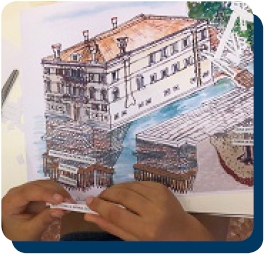 How does Venice work?
How does Venice work?
Understanding how Venice is made, how it works and how it worked in the past is the first step to living it, respecting and enjoying it. Why is the urban fabric of the city, which is so dense, characterised by so many campi and corti (squares)? Why is there a wellhead in every square? Why do the chimneys have such bizarre shapes? How do the houses and palaces stand in the water? These and many other questions will be answered in a special itinerary in which Ca’ Rezzonico lends itself perfectly as example and at the same time as a perfect observation point. We will start from the museum to reach the nearby Campo San Barnaba where we will see the wellhead in the center. Then we’ ll enter again at Ca’ Rezzonico by the water entrance to the palace on the Grand Canal. It is that here our exploration starts in search of answers to the above questions, and searching for the answers will lead us all the way up… to the attic! Each experience will then be documented and summarised in the workshop, during which the participants will put together a really special board they can take home in a “smart” version.
Available also in the Toolkit version.
Target: 2nd cycle primary school, lower and upper secondary school
Duration: 2h (1h 30 min in the toolkit version)
Language: Italian, English
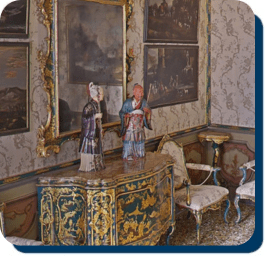 A fan from the fabulous Orient
A fan from the fabulous Orient
Dragon, rhinoceros, dog, camel, but also pagodas and lotus flowers… what stories, symbols and curiosities can these subjects from the fabulous Orient tell? The activity includes a first part ‘hunting’ for these images in the museum, then continues in the classroom with the decoration of a Chinese fan inspired by what participants saw earlier, using stencils, glues and lots of colours.
Target: nursery and primary school
Duration: 2h
Language: Italian, English, French
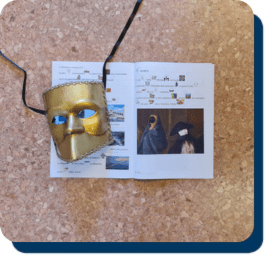 Easily Venice
Easily Venice
A notebook of riddles provides the map for experiencing a sort of itinerant treasure hunt through the rooms of Ca’ Rezzonico, to discover the symbolic elements of Venice hidden among the furnishings, paintings and museum spaces. This fun inclusive activity with Easy-to-read and Alternative Augmentative Communication (AAC) texts, ends in the workshop with the creation of a lapbook dedicated to the most beautiful city in the world, enriched also with good practices to become more aware and respectful visitors of the environment, the artistic beauties and traditions of Venice.
Target: primary school
Duration: 2h
Language: Italian, English
![]()
COMBINED TOURS
COMBINED TOUR CA’ REZZONICO & CASA DI CARLO GOLDONI
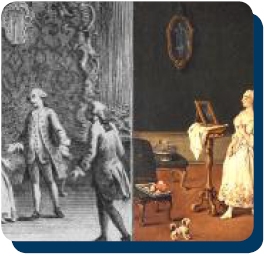 Carlo Goldoni and Pietro Longhi: two witnesses of their time
Carlo Goldoni and Pietro Longhi: two witnesses of their time
The venue for this fascinating tour is Casa Goldoni, where the first part of the activity takes place. Here the lively theatre scene of eighteenth-century Venice is explored and the salient aspects of Carlo Goldoni’s approach to the medium are outlined, together with his ‘revolutionary’ way of interpreting – in the theatre – many aspects of the real life of his time. The circuit then continues to Ca’ Rezzonico, the famous museum of the eighteenth century in Venice, where exactly the same approach and the same intentions can be seen in the paintings of Pietro Longhi, Goldoni’s friend. A closeness of which both were proud and which still allows all of us today to grasp the fundamental elements of a crucial era recorded with freshness and irony.
The tour between the two museums is followed independently. The meeting point with the operator supplying the activities is at Casa Goldoni.
Target: Lower and upper secondary school and higher education system (Universities etc.)
Duration: 2h 30 min
Language: Italian, English
![]()
GUIDED TOURS
 Carlo Goldoni in Eighteenth-century Venice
Carlo Goldoni in Eighteenth-century Venice
Starting from the evocative Gothic courtyard of Ca’ Centanni in San Tomà, the house in which Carlo Goldoni was born, the itinerary focuses on the life of the great Venetian playwright and the characteristics of the theatrical arts of his time, when there were fifteen theatres in the city, making Venice one of the capitals of European culture. The visit aims to retrace and understand the great theatrical and cultural revolution brought about by Goldoni in the eighteenth century, which substituted the masks of the commedia dell’arte for stories drawn from real life. The visit is rounded off by the wonderful puppet theatre on display in the museum.
Target: Lower and upper secondary school and higher education system (Universities etc.)
Duration: 1h
Language: Italian, English, French
WORKSHOPS
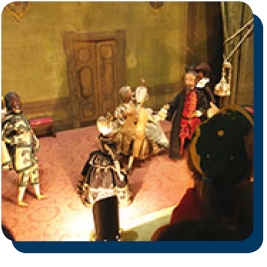 Puppets take Centre Stage
Puppets take Centre Stage
In one of its rooms, Casa Goldoni houses a precious puppet theatre with splendid original eighteenth-century puppets. In his own Mémoires, Goldoni mentions how, in this very house, his young self had played with such a puppet theatre – perhaps similar to this (but certainly less magnificent). After a short visit to the rooms with the puppet theatre and a lively account of some scenes from Goldoni’s plays (as depicted in the set pieces located within the museum), the workshop activity guides the children to construct cardboard puppets inspired by Goldoni’s characters
Target: Nursery and primary school
Duration: 1h 30 min
Language: Italian, English, French
![]()
GUIDED TOURS
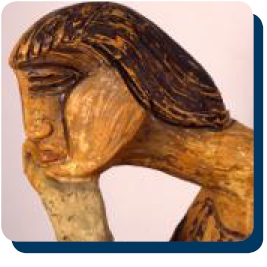 Journeys through the Twentieth Century
Journeys through the Twentieth Century
An exciting itinerary through the masterpieces of the International Gallery of Modern Art allows for evocations, comparisons and relationships between the many trends in twentieth-century art. The chronological and thematic progression of the exhibition, which presents, among others, artists of the calibre of Rodin, Klimt, Medardo Rosso, Wildt, Martini, Gino Rossi, Morandi, Casorati, Cha-gall, as well as a selection of exponents of Pop Art, Arte Povera, Minimal and Conceptual Art,* highlights the continuous process of experimentation and renewal at the basis of the artistic work of the ‘short century’. The connection between art and the great transformations of twentieth-century life also provides the cue for multiple opportunities for in-depth study and interdisciplinary links.
* The exhibition layout may be subject to change due to the loan of works for exhibitions in other venues or for updates to the museum’s layout.
Target: Lower and upper secondary school and higher education system (Universities etc.)
Duration: 1h 30 min
Language: Italian, English, French
WORKSHOPS
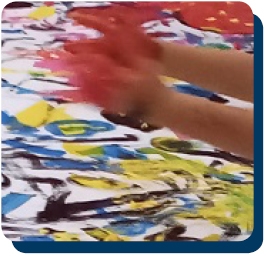 Trans-form with music and colours
Trans-form with music and colours
Direct observation of Kandinsky’s masterpiece ‘White Zig-Zags’, provides an excellent starting point for an active workshop in which the children after having familiarised themselves with geometric shapes, lines and colours, can try their hand at a true ‘collective’ artistic performance in which the individual shapes, transferred into the space of a long white sheet, become the protagonists of new figures and new stories.
The activity lends itself to deepening topological concepts relating to shapes, but also to an undestanding and knowledge of colours.
Target: Nursery and primary school
Duration: 2h
Language: Italian, English, French, Spanish
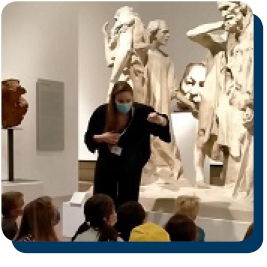 My art Gallery
My art Gallery
This activity includes an interactive visit to masterpieces exhibited in the International Gallery of Modern Art of Ca’ Pesaro, including Rodin’s “The bourgeois of Calais”, Klimt’s “Judith II” and “The ladies” of Casorati. Through this visit, the participants will rediscover the masterpieces with ‘new eyes’, a renewed appreciation of their beauty and of their details. For younger participants, the visit will take place and will be supported by the storytelling method. Through this method, the younger participants will use their body to trace the movements of some works; while for the older ones, the visit will alternate observation with moments of analysis, developing the critical skills necessary for the subsequent workshop. Once in the workshop, the students will experience the difficult yet ‘intriguing’ profession of the museologist, rearranging the museum’s works through a diorama that recreates perfectly a 3D art gallery.
This activity is also available in the Muve toolkit mode.
*The exhibition layout may be subject to change due to the loan of works for exhibitions in other venues or for updates to the museum’s layout.
Target: Primary and lower secondary school
Duration: 2h (1h 30 min in the toolkit mode)
Language: Italian, English, French
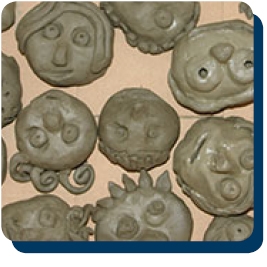 Clay faces
Clay faces
Sculpture, as we know, is one of the strengths of the Ca’ Pesaro collection: monumental works such as Rodin’s “Bourgeois of Calais”, or the intense waxes of Medardo Rosso or the perfect and expressive marbles of Adolfo Wildt can offer a formidable impact with this art also for the youngest. After a “targeted” tour in the museum, in the laboratory the children will be guided to shape their own sculpture with clay: a face, their own self-portrait or a subject inspired by the experience they have just lived.
Target: Primary school, lower and upper secondary school
Duration: 2h
Language: Italian, English, French
CLIL ACTIVITY – ENGLISH
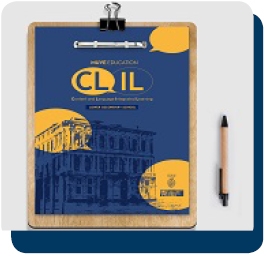 CLIL – Looking for the right words: Ca’ Pesaro as an opportunity for language practice
CLIL – Looking for the right words: Ca’ Pesaro as an opportunity for language practice
Differently modulated for first and second grade secondary schools, the CLIL activities in English (LS), conducted by highly specialised staff, take the form of interactive conversations which, with the help of support materials that then remain with the students, focus on the works, the spaces, the impressions and the emotions they generate.
Target: Lower (III class only) and upper secondary school
Duration: 2h
Language: Italian, English
![]()
GUIDED TOURS
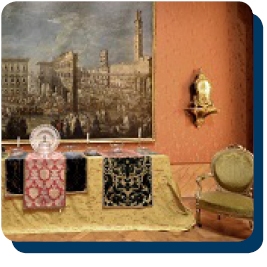 Voyage through an eighteenth-century home
Voyage through an eighteenth-century home
In the former home of the aristocratic Mocenigo family, the thematic tour takes visitors on a voyage of discovery past original clothing, accessories and fabrics, displayed alongside furnishings and works of art in what is effectively a ‘house-museum’ documenting the taste of an era, a time when Venice was one the main centres in Europe for the production not only of textiles but also of cosmetics and spices.
The display, to which is added a selection dedicated to eighteenth-century fashion in Venice, with a number of period dresses and petticoats, ends with a visit to the evocative perfume section.
Target: Lower and upper secondary school and higher education system (Universities etc.)
Duration: 1h 30 min
Language: Italian, English, French, Spanish
SPECIAL ITINERARIES
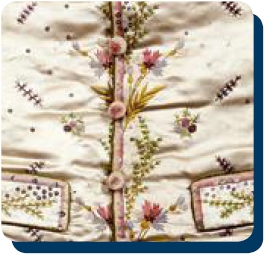 Workshop Backstage: hidden treasures of fashion and costume*
Workshop Backstage: hidden treasures of fashion and costume*
An unusual itinerary that leads from the exhibition rooms of the museum, where clothes, textiles, furnishings and works from the eighteenth century are on display, to the extremely rich storerooms on the second floor, in spaces that are not normally accessible to the public. Here are preserved the rarest, most delicate and precious textile artefacts in the collection. In these storerooms, it is possible to admire the sixteenth-century calcagnini, the high wedge shoes beloved of noblewomen and courtesans, the women’s and men’s dresses of eigtheenth-century Venice, such as the famous andrienne, the favourite style of dress of Venetian women of the time, or the marsine and sottomarsine worn by men, together with accessories such as the bauta, socks and bags. A unique and evocative experience that also allows you to understand how a museum works ‘behind the scenes’.
Target: Secondary school and higher education system (Universities etc.)
Duration: 2h
Language: Italian, English, French
WORKSHOPS
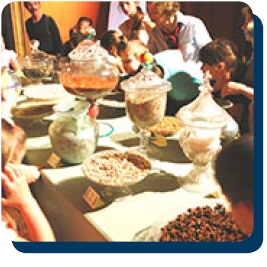 Hunt the Perfume
Hunt the Perfume
Having visited the part of the museum dedicated to the history of perfumes, to the raw materials and techniques used in their preparation, the children are involved in an activity that draws upon a number of senses. Using special teaching materials, they work in teams to explore the tactile and olfactory properties of natural raw materials – some in common use, some rather more rare. Gradually learning to identify these materials and their associations, they move step by step to the refined world of the fragrances whose complex combinations are at the origin of all perfumes.
Notes on architectural barriers: No lift; Staircase to reach the piano nobile of the museum; toilets at the first floor are not wheelchair-accessible; laboratory room at the ground floor.
Target: Nursery and primary school
Duration: 1h 30 min
Language: Italian, English, French
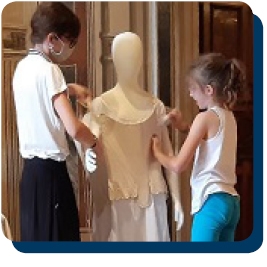 The fashion game at Palazzo Mocenigo
The fashion game at Palazzo Mocenigo
How did people live in a Venetian palace in the old days? What clothes did the gentlemen and ladies wear on different occasions of the day? Who were the ‘muskers’ and how is it that perfumes were produced in Venice? The furnishings, paintings, accessories, clothes and raw materials – all there to be sniffed! – on display at Palazzo Mocenigo tell the story of fashions and customs in eighteenth-century Venice, in a mix of opulence, elegance and cosmetic fashions. The activity is rounded off with two life-size mannequins used to make clear the complex ritual that dressing up entailed, together with paper dolls that can be coloured in, cut out and ‘dressed up’ in the workshop.
Available also in the Toolkit version.
Target: Primary and lower secondary school
Duration: 2h (1h30 min in the toolkit version)
Language: Italian, English, French
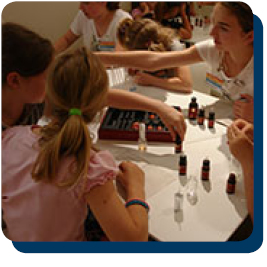 Perfumes Unveiled
Perfumes Unveiled
The workshop begins in the museum, where the students cover the history of perfumes and use multimedia equipment to chart the trade routes that linked different cultural and geographical areas; then, in the two rooms dedicated to the raw materials themselves, they get direct experience of their various odours. In the workshop, there is the opportunity to look in greater depth at classification of the different components that feature in all perfumes and to introduce the concept of “olfactory pyramid”. This leads on to to direct practical exercise: using the different essences, compounds and instruments of the trade, the students learn to construct their own personal perfume, which they can take away with them at the end of the session.
*Notes on architectural barriers: No lift; Staircase to reach the piano nobile of the museum; toilets at the first floor are not wheelchair-accessible; laboratory room at the ground floor.
Target: Primary school, lower and upper secondary school and higher education system (Universities etc.)
Duration: 2 h
Language: Italian, English, French, Spanish
![]()
GUIDED TOURS
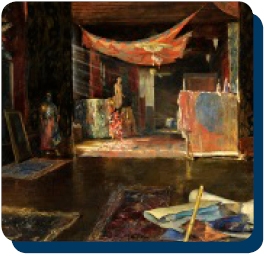 In the ‘studio-home’ of Mariano Fortuny
In the ‘studio-home’ of Mariano Fortuny
For the reopening of the Museo di Palazzo Fortuny with a completely new layout dedicated to the multifaceted and industrious genius of Mariano Fortuny y Madrazo (1871-1949) and his muse and wife Henriette Nigrin, a special thematic itinerary follows in the footsteps of this extraordinary exponent of the Venetian and European art scene at the cusp of the nineteenth and twentieth centuries, in what was once his home and studio in Campo San Beneto in the evocative setting of Palazzo Pesaro degli Orfei.
The tour takes place on the first floor of the palace, an exceptional example of Venetian floral Gothic, where the ‘spirit’ of the Genius loci, Spanish by origin but Venetian by adoption, still hovers: in the salon, furnished in the ‘Fortuny style’, and in the adjoining rooms, the life, art and collecting of the family, who lived here from 1898 to 1965, are revealed. From his first experiences with painting, copying the great artists of the past along with the works of his father Mariano Fortuny y Marsal (1838-1874), visitors move on to the Wagnerian cycle, and from the splendid printed fabrics to the pleated dresses, including the legendary ‘Delphos’ – a creation of Hellenistic inspiration – and so to the innovations in the field of stage design and lighting, such as the ingenious ‘cupola’ with which he revolutionised the theatre of the early 1900s.
The itinerary provides a fascinating journey revealing the extraordinary eclectic genius of an artist who perfectly embodied the concept of ‘total art’ so dear to Wagner.
Target: Lower and upper secondary school and higher education system (Universities etc.)
Duration: 1h 30 min
Language: Italian, English, French, Spanish
![]()
GUIDED TOURS
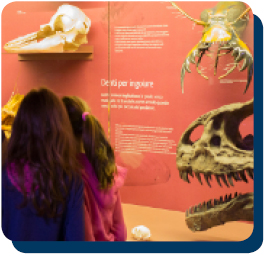 Nature in a museum: stories and collections
Nature in a museum: stories and collections
A visit to this museum is a fascinating experience that brings many different senses into play: in each room, touch, sight and hearing all contribute to our understanding. And each section of the museum is a complete unit, making the place a series of museums within the museum. The first “journey” one undertakes is to the origins of life on earth, exploring fossils and the world of dinosaurs. Then one looks at how natural history collections themselves have evolved, from the days of ancient explorers to those of modern scientific researchers. And finally there is a fascinating section that looks at the enormous variety in the strategies upon which the maintenance of life depends – from movement to nutrition.
Target: Primary school, lower and upper secondary school and higher education system (Universities etc.)
Duration: 1h 30 min
Language: Italian, English
CLIL ACTIVITY – ENGLISH
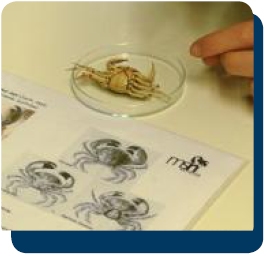 CLIL – Exploring the lagoon
CLIL – Exploring the lagoon
A visit held in English (FL) to deepen one’s knowledge of the multiplicity of habitats and organisms that characterise the Venetian lagoon. The workshop includes the observation of finds, the use of cartography and some small experiments, flanked by listening and conversation activities to facilitate the learning of a specialised vocabulary.
Target: Upper secondary school (I and II grade)
Duration: 2h
Language: Italian, English
![]()
GUIDED TOURS
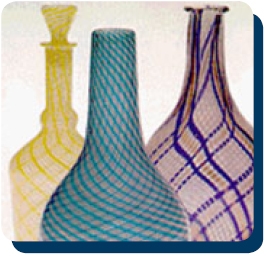 A Story of Skill, Sand and Fire
A Story of Skill, Sand and Fire
The thousand-year craft of Venetian glass-making is recounted in a guided tour through the rooms of the museum, which house some of the famous works that made, and continue to make, the city’s glass legendary throughout the world – not only for the technical skill of its craftsmen but also for the creativity of the artists and designers who have drawn inspiration from the huge potential of glass as a material.
Target: Nursery school, primary school, lower and upper secondary school and higher education system (Universities etc.)
Duration: 1h 30 min
Language: Italian, English, Spanish
INTERACTIVE ITINERARIES
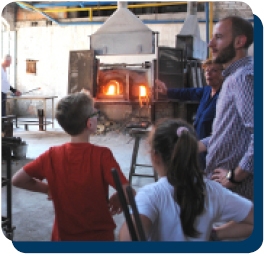 A Story of Skill, Sand and Fire (with glassworking demonstration)
A Story of Skill, Sand and Fire (with glassworking demonstration)
In addition to the same activity as described in the previous proposal, which includes a guided tour of the museum, for a small increase in price there is also the possibility of visiting the furnace of the Abate Zanetti Glass School, where a demonstration by a master glassmaker takes place.
Target: Nursery school, primary school, lower and upper secondary school and higher education system (Universities etc.)
Duration: 2h
Language: Italian, English
![]()
GUIDED TOURS
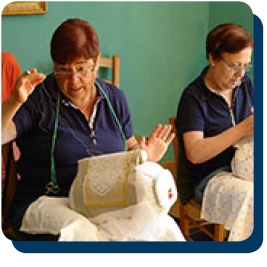 Lace and Lacemakers
Lace and Lacemakers
In addition to the splendid display of lace ranging from the sixteenth to the twentieth century, the museum’s guided tour includes a real-life look at the complex and original lace-making techniques used by the island’s last lace-makers, who offer a lively and highly skilled testimonial to their craft.
Target: Lower and upper secondary school and higher education system (Universities etc.)
Duration: 1h
Language: Italian, English, Spanish
WORKSHOPS
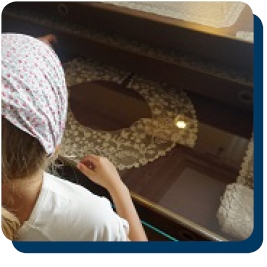 All the knots come to a head!
All the knots come to a head!
However complex, lace fabric is always based upon knots and weaves . But do we really know how to distinguish one from the other? Practical trial and experiment reveals just how common these knots and weaves are throughout our daily existence, and just how skilfully they can be used in arts and crafts.
After a visit to the more than two hundred rare and precious specimens of the museum, from the 16th to the 20th century, a fun game of recognition will follow with natural and artificial examples (bird’s nests, shoe laces, wicker hats and chairs, hair, sea knots …), With which the participants will learn to recognize the differences between ‘knots’ and ‘intertwining’.
The activity ends with the practical realization of a ‘basic’ weave with needle and wool thread on a particular support to be taken home.
Target: nursery and primary school.
Duration: 1h 30 min
Language: Italian, English, Spanish
![]()
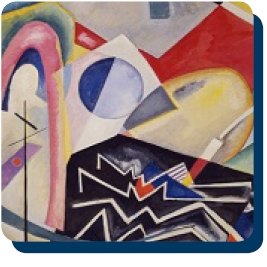 KANDINSKY AND THE AVANT-GARDES. Point and line to plane – Virtual Tour
KANDINSKY AND THE AVANT-GARDES. Point and line to plane – Virtual Tour
An extraordinary opportunity that allows you to enjoy an unusual and suggestive visit to the exhibition “KANDINSKY AND THE AVANT-GARDES. Point and line to plane”, with its works of a thousand shapes and colors, punctually enriched with information and in-depth tags that allow you to understand at best particular aspects not only related to the Russian artist but also to the other protagonists present with their masterpieces, such as Klee, Mirò, Tapiès, Arp, Chillida, Vedova, Deluigi, Tancredi, Nonas, Mangold and the movements that interested them, abstraction, abstract expressionism or the informal.
Target: Lower and upper secondary school and higher education system (Universities etc.)
Duration: 1h
Language: Italian, English, Spanish
![]()
Note on architectural barriers:
All the museums are equipped with a lift, except Palazzo Mocenigo*.
At the Museo Correr the lift is located at no. 52 Piazza San Marco (entrance between Caffè Florian and Caffè Aurora). To gain access to it you must call +39 0412405234 before your visit.
(*) There is no lift at Palazzo Mocenigo; there is a staircase leading to the main floor of the museum; toilets without provision for the disabled are on the first floor; laboratory room on the ground floor.